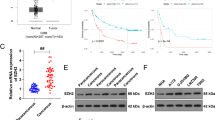Abstract
Objective
This study investigates the function and regulatory mechanism of lncRNA LINC00852 in hepatocellular carcinoma (HCC) cells.
Methods
The effects of LINC00852 and E2F1 on HCC cell proliferation, invasion, migration and apoptosis were measured by MTT assay, Transwell invasion and migration assays and TUNEL staining, respectively. The apoptosis of HCC cells was further determined by the expression levels of apoptosis-related proteins (Bax and Bcl2). Dual-luciferase reporter assays verified the targeting relationships among LINC00852, miR-625 and E2F1.
Results
Overexpression of LINC00852 was positively associated with HCC cell proliferation, invasion and migration while negatively associated with the cell apoptosis. LINC00852 bound miR-625 which further targeted E2F1. Overexpressing miR-625 or down-regulating E2F1 reversed the oncogenic effects of LINC00852.
Conclusion
LINC00852 regulates HCC cell activities via the miR-625/E2F1 axis.





Similar content being viewed by others
References
Beermann, J., M. T. Piccoli, J. Viereck, and T. Thum. Non-coding RNAs in development and disease: Background, mechanisms, and therapeutic approaches. Physiol Rev. 96:1297–1325, 2016.
Burja, B., et al. Olive leaf extract attenuates inflammatory activation and DNA damage in human arterial endothelial cells. Front Cardiovasc Med. 6:56, 2019.
Castelli, G., E. Pelosi, and U. Testa. Liver cancer: molecular characterization, clonal evolution and cancer stem cells. Cancers (Basel). 9:127, 2017.
Chen, H. Z., S. Y. Tsai, and G. Leone. Emerging roles of E2Fs in cancer: an exit from cell cycle control. Nat Rev Cancer. 9:785–797, 2009.
De Stefano, F., et al. Novel biomarkers in hepatocellular carcinoma. Dig. Liver Dis. 50:1115–1123, 2018.
Du, W. W., et al. A circular RNA circ-DNMT1 enhances breast cancer progression by activating autophagy. Oncogene. 37:5829–5842, 2018.
Ertosun, M. G., F. Z. Hapil, and O. Osman-Nidai. E2F1 transcription factor and its impact on growth factor and cytokine signaling. Cytokine Growth Factor Rev. 31:17–25, 2016.
Fang, W., et al. microRNA-625 inhibits tumorigenicity by suppressing proliferation, migration and invasion in malignant melanoma. Oncotarget. 8:13253–13263, 2017.
Fang, L., D. Kong, and W. Xu. MicroRNA-625-3p promotes the proliferation, migration and invasion of thyroid cancer cells by up-regulating astrocyte elevated gene 1. Biomed Pharmacother. 102:203–211, 2018.
Farra, R., et al. The role of the transcription factor E2F1 in hepatocellular carcinoma. Curr Drug Deliv. 14:272–281, 2017.
Forner, A., M. Reig, and J. Bruix. Hepatocellular carcinoma. Lancet. 391:1301–1314, 2018.
Global Burden of Disease Liver Cancer Collaboration, et al. The burden of primary liver cancer and underlying etiologies from 1990 to 2015 at the global, regional, and national level: results from the global burden of disease study 2015. JAMA Oncol. 3(1683–1691):2017, 1990.
Gong, X., B. Xu, L. Zi, and X. Chen. miR-625 reverses multidrug resistance in gastric cancer cells by directly targeting ALDH1A1. Cancer Manag Res. 11:6615–6624, 2019.
Gu, Y., et al. SET7/9 promotes hepatocellular carcinoma progression through regulation of E2F1. Oncol Rep. 40:1863–1874, 2018.
Hollern, D. P., et al. E2F1 drives breast cancer metastasis by regulating the target gene fgf13 and altering cell migration. Sci Rep. 9:10718, 2019.
Jin, L., C. Li, T. Liu, and L. Wang. A potential prognostic prediction model of colon adenocarcinoma with recurrence based on prognostic lncRNA signatures. Hum Genomics. 14:24, 2020.
Li, Q., et al. Exosome-transmitted linc00852 associated with receptor tyrosine kinase AXL dysregulates the proliferation and invasion of osteosarcoma. Cancer Med. 9:6354–6366, 2020.
Liu, P., et al. LINC00852 promotes lung adenocarcinoma spinal metastasis by targeting S100A9. J Cancer. 9:4139–4149, 2018.
Pan, W., et al. lncRNA-PDPK2P promotes hepatocellular carcinoma progression through the PDK1/AKT/Caspase 3 pathway. Mol Oncol. 13:2246–2258, 2019.
Schmitt, A. M., and H. Y. Chang. Long noncoding RNAs in cancer pathways. Cancer Cell. 29:452–463, 2016.
Sia, D., A. Villanueva, S. L. Friedman, and J. M. Llovet. Liver cancer cell of origin, molecular class, and effects on patient prognosis. Gastroenterology. 152:745–761, 2017.
Wang, Z., et al. miR-625 down-regulation promotes proliferation and invasion in esophageal cancer by targeting Sox2. FEBS Lett. 588:915–921, 2014.
Wang, Y., et al. A novel lncRNA MCM3AP-AS1 promotes the growth of hepatocellular carcinoma by targeting miR-194-5p/FOXA1 axis. Mol Cancer. 18:28, 2019.
Wang, L., et al. LINC00958 facilitates cervical cancer cell proliferation and metastasis by sponging miR-625-5p to upregulate LRRC8E expression. J Cell Biochem. 121:2500–2509, 2020.
Wu, Z., S. Zheng, and Q. Yu. The E2F family and the role of E2F1 in apoptosis. Int J Biochem Cell Biol. 41:2389–2397, 2009.
Xu, T. P., et al. E2F1 induces TINCR transcriptional activity and accelerates gastric cancer progression via activation of TINCR/STAU1/CDKN2B signaling axis. Cell Death Dis. 8:e2837, 2017.
Zhang, Y., et al. Identification of potential prognostic long non-coding RNA biomarkers for predicting recurrence in patients with cervical cancer. Cancer Manag Res. 12:719–730, 2020.
Zheng, H., et al. MiR-625-3p promotes cell migration and invasion via inhibition of SCAI in colorectal carcinoma cells. Oncotarget. 6:27805–27815, 2015.
Zhou, X., et al. miR-625 suppresses tumour migration and invasion by targeting IGF2BP1 in hepatocellular carcinoma. Oncogene. 35:5078, 2016.
Zhou, W. B., et al. miR-625 suppresses cell proliferation and migration by targeting HMGA1 in breast cancer. Biochem Biophys Res Commun. 470:838–844, 2016.
Author Contributions
CS conceived the ideas; designed the experiments; performed the experiments; analyzed the data; provided critical materials; wrote the manuscript; supervised the study.All the authors have read and approved the final version for publication.
Funding
This research didn’t receive any funding.
Conflict of interest
The authors report no relationships that could be construed as a conflict of interest.
Ethics Approval and Consent to Participate
Experiments of this study were approved by the ethics committee of Hunan Cancer Hospital.
Author information
Authors and Affiliations
Corresponding author
Additional information
Associate Editor Michael R. King oversaw the review of this article.
Publisher's Note
Springer Nature remains neutral with regard to jurisdictional claims in published maps and institutional affiliations.
Rights and permissions
About this article
Cite this article
Chen, S. LINC00852 Regulates Cell Proliferation, Invasion, Migration and Apoptosis in Hepatocellular Carcinoma Via the miR-625/E2F1 Axis. Cel. Mol. Bioeng. 15, 207–217 (2022). https://doi.org/10.1007/s12195-021-00714-8
Received:
Accepted:
Published:
Issue Date:
DOI: https://doi.org/10.1007/s12195-021-00714-8




